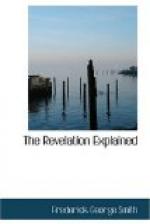It is said that “white robes were given unto every one of them.” By referring to chap. 3:4; 7:9, 13, 14, it will be seen that “white garments” and “white robes” are sometimes used as a symbol to describe a part of the heavenly inheritance. The martyr-spirits, although impatient at the delay of avenging judgment, received a righteous reward. But the period of tribulation to the church was not yet over. The cup of iniquity in the hands of her enemies was not yet full, and they were told to “rest for a little season, until their fellowservants also, and their brethren, that should be killed as they were, should be fulfilled.” The account given seems to indicate an important epoch, a period in which the martyrs had reason to expect the vindication of their righteous blood, but which, instead, was to be followed by another great period of persecution. Considering the time of the events already described in this series of prophecy, we have no difficulty in fixing the chronology of this event at the dividing-point between the era of Papal supremacy and the age of Protestantism—or at the Reformation of the Sixteenth Century. Did severe slaughter and persecution follow the Reformation? Witness the reign of Mary Tudor, frequently styled “Bloody Mary.” During three years of her reign, 1555 to 1558, two hundred and eighty-eight were burnt alive in England! Think of the inhuman massacre of the innocent Waldenses of southern France by the violent bigot Oppede (1545), who slew eight hundred men in one town, and thrust the women into a barn filled with straw and reduced the whole to ashes—only a sample of his barbarity; or of their oppression in southern Italy by Pope Pius IV. (1560), at whose command they were slain by thousands, the throats of eighty-eight men being cut on one occasion by a single executioner! Witness the horrible massacre of St. Bartholomew in Paris (Aug. 21, 1572), when the Queen dowager, the infamous Catherine de Medici, lured immense numbers of the innocent Hugenots into the city under the pretext of witnessing a marriage between the Hugenot Henry,




